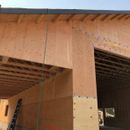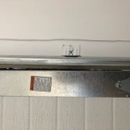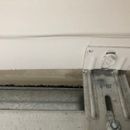Garage door flashing / sealing
With a standard garage door that rolls up and down, I can’t find anything to suggest how to properly flash the one in the shop we are building like I’ve found for other doors and windows – any suggestions? Maybe it’s because trim (like Hardie trim we will be using) goes up to it all the way & then just roller railing on jams. I notice in the house we are in currently, there is an air gap between interior sheetrock and metal railing/framing. I would think we’d want to use something to seal up that somehow?
GBA Detail Library
A collection of one thousand construction details organized by climate and house part












Replies
Jamie,
I'm not quite sure if you mean flashing or sealing the door, so I'll answer both.
- The head of the door trim gets metal flashing, covering what is typically a 2"x6" or 2"x8". The jambs, like the jambs on a window, get no flashing.
- Sealing the door is all done on the exterior with vinyl weatherstripping attached to the jamb and head trim. The bottom of the door should come with a gasket that seals the door to the slab below when it is closed. There is no benefit or effective way to seal the interior, or track.
- There has been some discussion here on GBA about trying to provide a thermal-break at the bottom of the door. My own feeling is garage doors are inherently leaky and poor insulators, and it isn't worth getting too worried about a space that doesn't need much heat to be useful.
Hey - thanks, Malcolm! We are actually going to be living in our new shop for a couple years while we build our new home, so I was hoping to seal it a little better. I think I was meaning sealing - thanks for being so kind!
By head of the door getting metal flashing, do you mean like drip cap or drip edge (as that is similar to windows)?...so I'm thinking that's what you meant as windows are suppose to get flashing tape on flanges at jambs then head.
Bummer, I can totally see an air gap between sheetrock and track/rail for garage door rollers.
Jamie,
If you are going to be using the garage as living space for a while, I'd suggest taping the door shut, and taping the seam between all the panels. Even with the best of intentions and diligence, garage doors remain a real weak link in any energy efficient house.
Typically the rough opening gets a surround of 2"x material that is installed flush with the interior face of the drywall, and protrudes slightly past the siding. So the only flashing it needs is a drip cap to keep water from getting onto that surround at the head.
Malcolm, you're teaching me - thank you! Here is the garage door we ordered http://www.nwdusa.com/residential/therma-tech-collection/ Head looks more embedded and doesn't look to come out past siding - do you think a drip cap is still necessary here above the head's trim?
That interior gap between drywall and track for doors' rollers [where we can see daylight] - you wouldn't think some sort of tape or caulking would be a good idea?
Assuming you don't need a garage overhead door while using it as a residence, have you considered making fake double swinging doors? Like the attached picture, only in-operable? You could seal it to the rest of your air barrier and when it comes time to make it a shop again, just rip it out and install your overhead door.
Good thought - thank you, Yupster :) I don't think my husband will go for putting something in that we would take out and redo. He's been a developer/construction man for 20 some years and his wife's building science 101 "helping" to do's [changing "normal" building industry practices] are wearing him thing. Thanks for trying to help with some thoughts!
Jamie,
Sorry - I'm not being very clear with my description. The rough-opening is surrounded by 2"x trim that is flush with the surface of the drywall inside, and typically sits a little proud of whatever siding you are using on the exterior. Because it protrudes past the siding, it's a good idea to run a drip-flashing at the head of the 2"x door trim (not the door, which as you say is well protected. It gets the vinyl weatherstripping). If the door is close to an overhang above, the flashing could probably be omitted.
I'm still not understanding where you are seeing daylight at the door track. They typically are mounted to brackets fastened through the drywall, and the door overlaps the 2"x trim. All that is well inside where you want to be stopping cold air from penetrating.
Yupster brings up a good point. Thinking about it again, I'd be inclined to trim out the opening, but then build a stud-wall which could be sheathed, made weatherproof with House-wrap, and insulated. That would keep you a lot more comfortable for the couple of years you occupy the garage than the door will.
Oh, Malcolm - okay, I'm getting it...thanks! Attached is the garage door opening to the right - think 2 ft overhang is close enough to door or probably should run drip flashing at head?
I attached a couple pics of where I'm seeing daylight inside. This is a pic of a current new building we are temporarily staying in but trying to learn what to-do's or not to-do's from this house, when I can.
Yep I gotcha both on that - two people and need to compromise with my husband. Thanks - good thoughts, maybe someone else will need to see that in the future :)
Whoops, why didn't they come through (trying again)..
Malcolm, finally! Pics attached up in original post I edited :)
What you need to seal that is an exterior seal for garage doors. Looks something like this https://www.amazon.com/Professional-Grade-Weather-stripping-Overhead-Installation/dp/B00QSG8JL2
Not going to help you meet Passivehaus standards but will stop the majority of drafts and definitely stop the daylight from coming through!
You could tape or caulk that gap but then your garage door would be inoperable and you would have to remove the tape or caulk everytime you wanted to open the door.
Ah - lol, now I feel silly! I see what you mean - didn't realize sheetrock gap was at rail w rollers that traveled up/down. Thanks for the link, I'll show husband and garage installer :) That looks like a best possible approach given what we are doing!
I asked Malcolm also but do you think need drip cap on top (or not) given location of head to 2 foot eves?
Thanks, Yupster!!
For the cost and time involved, I would put a drip cap in. Most siding guys will have an aluminum brake on hand and bend one up in a minute. At least in my area they do :)
Great - thanks for tips, Yupster!